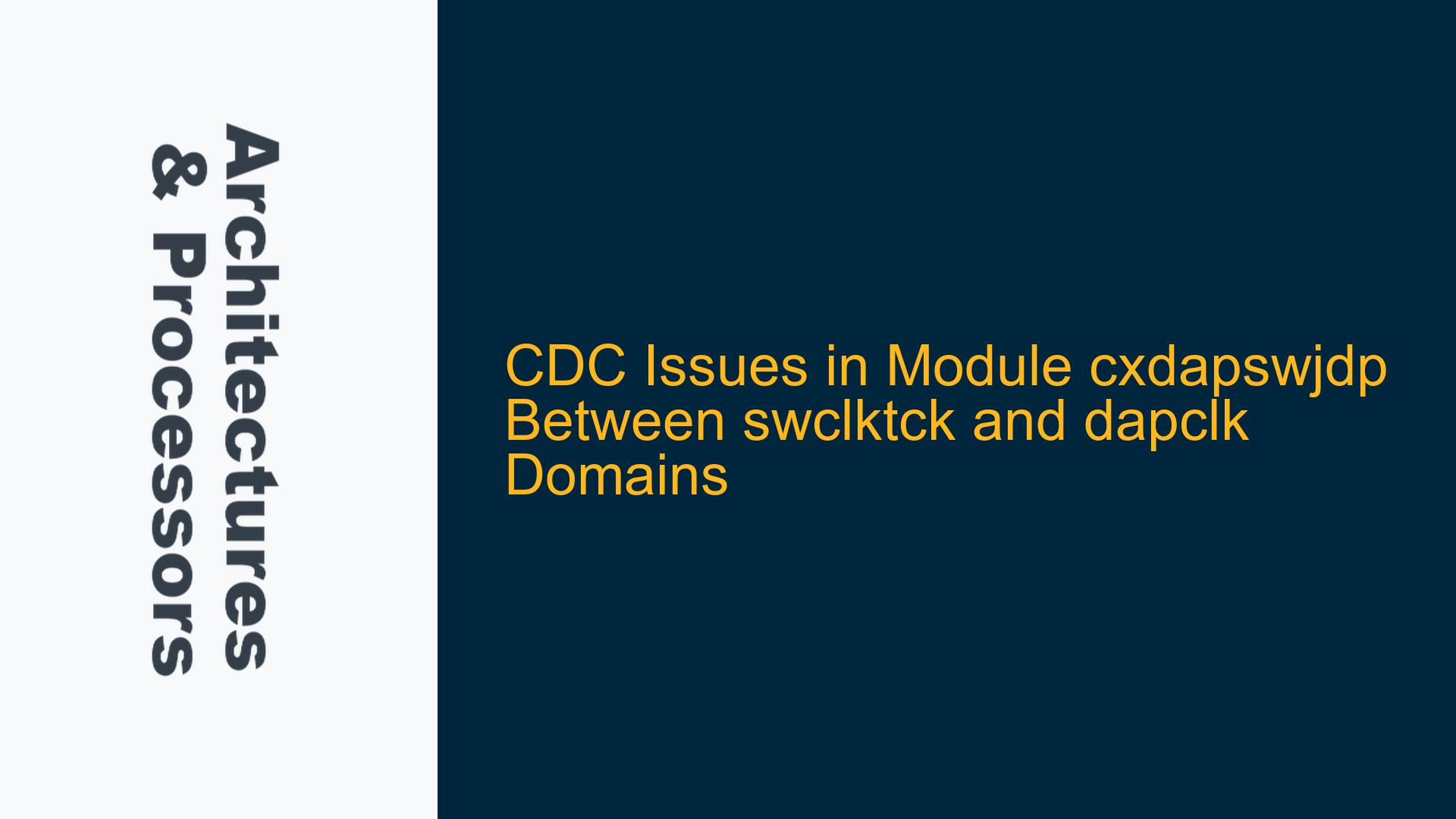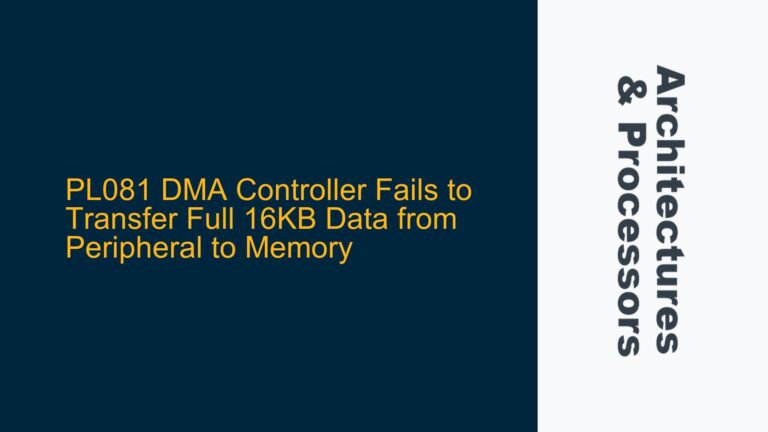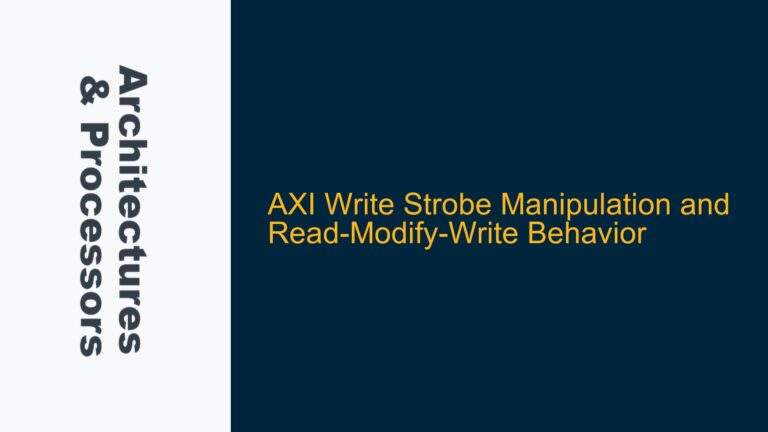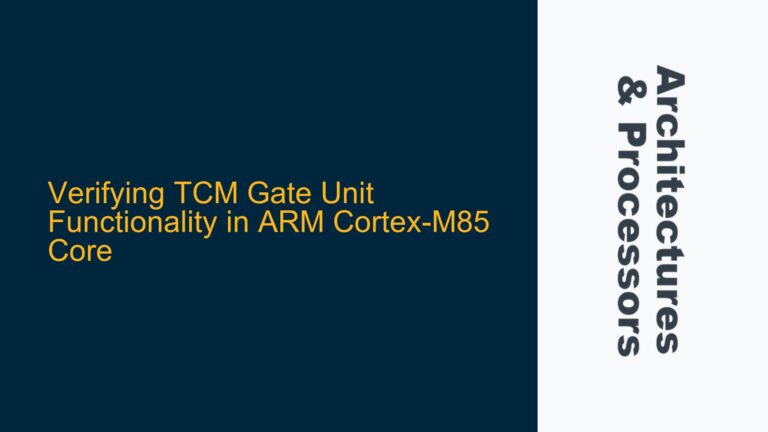Clock Domain Crossing (CDC) Violations in cxdapswjdp Module
The cxdapswjdp module is a critical component in the CoreSight debug architecture, responsible for interfacing between the SWCLKTCK and DAPCLK clock domains. Clock Domain Crossing (CDC) violations detected by Spyglass in this module indicate potential synchronization issues between these two asynchronous clock domains. The SWCLKTCK domain typically operates at a lower frequency, often tied to the JTAG interface, while the DAPCLK domain is associated with the Debug Access Port (DAP) and may run at a higher frequency. The absence of explicit CDC synchronization mechanisms in the cxdapswjdp module raises concerns about metastability risks, data corruption, and functional failures during debug operations.
The Spyglass CDC check flags violations because the design does not implement standard CDC synchronization techniques such as dual-flop synchronizers, handshake protocols, or FIFO-based synchronization for signals crossing between the SWCLKTCK and DAPCLK domains. This omission is particularly problematic because the cxdapswjdp module handles control and data signals that are critical for debug functionality, including breakpoint triggers, watchpoint updates, and trace data transfers. Without proper CDC handling, these signals may experience metastability, leading to unpredictable behavior in the debug subsystem.
The relationship between the SWCLKTCK and DAPCLK domains is inherently asynchronous, meaning their phase and frequency relationships are not fixed. Even if the frequencies are harmonically related, the lack of a known phase relationship necessitates CDC synchronization. The cxdapswjdp module must ensure that all signals crossing between these domains are properly synchronized to prevent metastability and ensure reliable operation. The absence of such mechanisms in the current design is a significant oversight that must be addressed to achieve robust debug functionality.
Missing Synchronization Logic and Frequency Constraints
The root cause of the CDC violations in the cxdapswjdp module lies in the lack of explicit synchronization logic between the SWCLKTCK and DAPCLK domains. The module assumes that the two clock domains can operate independently without synchronization, which is incorrect for asynchronous clock domains. This assumption may stem from a misunderstanding of the clock domain relationships or an oversight during the design phase. Additionally, the absence of frequency constraints or synchronization mechanisms suggests that the design does not account for the potential variability in clock frequencies and phases.
The SWCLKTCK domain is typically driven by an external JTAG interface, which may operate at a wide range of frequencies depending on the debug tool and target system. The DAPCLK domain, on the other hand, is often derived from the system clock and may vary based on the operating mode of the SoC. The lack of synchronization logic in the cxdapswjdp module means that signals crossing between these domains are susceptible to metastability, which can propagate through the debug subsystem and cause functional failures.
Another possible cause of the CDC violations is the use of shared resources or signals between the SWCLKTCK and DAPCLK domains without proper isolation. For example, if the cxdapswjdp module uses a shared register or signal to communicate between the two domains, the absence of synchronization logic can lead to race conditions and data corruption. This issue is exacerbated by the asynchronous nature of the clock domains, which makes it impossible to guarantee the timing of signal transitions.
The design may also lack proper constraints or assertions to guide the synthesis and verification tools in handling CDC scenarios. Without these constraints, the tools may not recognize the need for synchronization logic or may optimize away critical CDC structures. This can result in a design that passes functional simulation but fails in real-world operation due to metastability issues.
Implementing Synchronization Logic and Verification Strategies
To resolve the CDC violations in the cxdapswjdp module, the design must incorporate explicit synchronization logic between the SWCLKTCK and DAPCLK domains. The first step is to identify all signals that cross between these domains and classify them based on their synchronization requirements. Control signals, such as reset and enable signals, typically require dual-flop synchronizers to prevent metastability. Data signals, such as debug trace data or breakpoint addresses, may require more advanced synchronization techniques, such as handshake protocols or FIFO-based synchronization.
For control signals, dual-flop synchronizers should be implemented to ensure that signals are stable before being used in the destination clock domain. The synchronizer consists of two flip-flops in series, both clocked by the destination domain clock. The first flip-flop captures the signal from the source domain, and the second flip-flop provides a stable output to the destination domain. This approach minimizes the risk of metastability but introduces a latency of two destination clock cycles.
For data signals, a handshake protocol or FIFO-based synchronization may be more appropriate. A handshake protocol uses request and acknowledge signals to coordinate the transfer of data between clock domains. The sender in the source domain asserts a request signal, and the receiver in the destination domain acknowledges the request once the data has been safely captured. This approach ensures that data is transferred reliably but introduces additional latency and complexity.
FIFO-based synchronization is another option for data signals, particularly when transferring large amounts of data or when the data rate is variable. A FIFO buffer is used to store data in the source domain, and a separate read pointer is used to retrieve data in the destination domain. The FIFO must be designed to handle the asynchronous nature of the clock domains, typically using Gray code counters for the read and write pointers to ensure safe transitions.
In addition to implementing synchronization logic, the design must include proper constraints and assertions to guide the synthesis and verification tools. Clock domain crossing constraints should be defined to ensure that the tools recognize the asynchronous nature of the SWCLKTCK and DAPCLK domains. These constraints should specify the maximum clock frequencies, the relationship between the clocks, and the synchronization techniques used. Assertions should be added to verify that the synchronization logic is functioning correctly and that no CDC violations occur during simulation.
The verification strategy for the cxdapswjdp module should include both static and dynamic CDC checks. Static CDC checks, such as those performed by Spyglass, are essential for identifying potential CDC issues early in the design process. These checks should be run regularly to ensure that no new CDC violations are introduced as the design evolves. Dynamic CDC checks, performed during simulation, are necessary to validate the synchronization logic under realistic operating conditions. These checks should include corner cases, such as extreme clock frequency ratios and rapid clock domain transitions, to ensure robust operation.
Finally, the design should be validated on silicon to confirm that the CDC synchronization logic performs as expected in real-world conditions. This validation should include stress testing with varying clock frequencies and phases to ensure that the cxdapswjdp module can handle the full range of operating conditions. Any issues identified during silicon validation should be addressed through design updates and additional verification efforts.
By implementing these synchronization techniques and verification strategies, the cxdapswjdp module can achieve reliable operation across the SWCLKTCK and DAPCLK domains, eliminating the CDC violations detected by Spyglass and ensuring robust debug functionality in the SoC.






